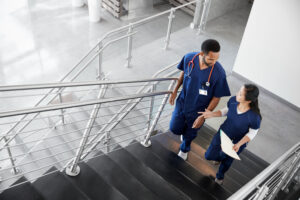Hospital asset management – like any other inventory management processes in other industries – can be complex.
Being able to locate hospital equipment quickly and efficiently, maintain appropriate inventory stock, receive insights for regular maintenance of equipment and track their whereabouts can help empower hospitals to continue their focus on providing seamless, efficient planned care delivery and services to patients.
This is where RTLS – Real Time Location Systems – comes in.
RTLS is not a “new” concept in healthcare.
Indeed, through our own implementation of asset tracking solutions in Australian health and aged care facilities, RTLS is a chosen system for tracking the location of hospital equipment.
Of course, it is also a system used within healthcare to track persons in real or near-real-time.
Both these RTLS applications present many benefits to the sector, from operational efficiencies through to – importantly – enhancing staff safety and patient care.
RTLS in healthcare
The International Journal of Health Geographics define RTLS as “consist[ing] of specialised fixed receivers or readers (location sensors) receiving wireless signals from small ID badges or tags attached to objects of interest and/or persons, to determine where the tagged entities are located within a building or some other confined indoor or outdoor space.”
In a healthcare facility, these “tracked objects” could be wheelchairs, or code blue equipment whilst ‘persons’ can refer to nurses, porters, patients, or doctors.
Location technology to enhance patient safety
RTLS is often used for patient tracking in hospitals and outpatient clinics, giving healthcare workers visibility as patients move between locations.
For example, in the event of an evacuation emergency, RTLS – which can be incorporated into patient ID tags and staff badges – can send real-time information to a dashboard or clinical mobile device to locate everyone’s whereabouts so that the right assistance can be sent to ensure a safe exit from wards, sections or whole buildings.
At Olinqua, we integrate RTLS into our Messaging Integration Engine – a middleware platform that collects the data / information from tags, badges, or equipment in which RTLS is incorporated and formats it to a notification, alert, or message to a clinical mobile device to the right person/s.
The capabilities of RTLS to promote and deliver patient safety is also being used innovatively at various healthcare facilities:
- At Huntsville Hospital in the US, Cisco – who Olinqua has the opportunity to partner with to enhance digital health – worked with Stanley Healthcare to promote a culture of hand-hygiene compliance through RTLS technology. They used an embedded device in soap machines linked to healthcare workers’ RTLS WI-FI devices, collecting data on how often specific staff use the dispensers for knowledge on which areas or departments of the hospital require further encouragement. The initiative has improved hand-hygiene compliance by 58%, supporting cleaner and safer healthcare delivery in the hospital.
- Huntsville Hospital is also leveraging their WI-FI network to connect RTLS devices to enable tracking and monitoring of patient location and movement for contact tracing.If a patient becomes ill and contagious, staff can retroactively contact trace the patient’s movements, equipment and staff contact using RTLS that is embedded in the device or tags associated with the patient. This information then becomes available in a database to show who and what had contact with the infected person, based on the proximity of the devices to each other.In a contagious hospital environment this RTLS capability can save lives, as administrators can isolate patients and/or assets that have made contact with the infected patient, to limit the contagion.In light of the current COVID-19 pandemic, contact tracing through RTLS technology can be an important support tool to further protect immunocompromised or vulnerable patients.
RTLS to further support staff safety
Through our team’s discussions with healthcare workers and experiences within hospital environments, we know that fixed alarms on hospital walls and other fixtures support staff members’ safety.
RTLS play a key role in our mobile duress technology.
The location system is embedded into fobs or devices that can be clipped to healthcare workers’ clothing.
Like the above-mentioned critical incident management scenario, the fob or device is then incorporated into our Messaging Integration Engine that subsequently distributes the messages to the relevant switchboard devices, PCs, smartphones or WIFI handsets that a healthcare facility uses.
In the instance that duress buttons or safety tags attached mobile devices are activated, a code black will be triggered, sending the precise location of a healthcare worker under duress or assault to the teams on the floor and the security groups.
An updated location notification will also be sent if said healthcare worker changes their location.
By supporting better safety and wellbeing of healthcare professionals, clinicians, nurses, and workers in a hospital can be empowered to focus on delivering quality customer service and patient care.
RTLS for operational benefits
In addition to supporting patient and staff safety, RTLS can also help hospitals track the whereabouts of their key assets and prevent theft of hospital equipment, contributing to time efficiencies and resource savings.
For example, within the Olinqua platform, our asset tracking solution uses RTLS to provide solutions commonly associated with hospital equipment, including:
- Reducing ad hoc searching – by incorporating location sensors to various equipment, hospital workers can identify where assets such as wheelchairs, electrocardiograms or intravenous pumps can be located easier and faster. This saves valuable time that can be focused onto other urgent matters and delivering patient care.
- Stopping perimeter breaches – RTLS sensors on equipment can send notifications or alarms when an asset is taken off its “normal” location, helping with anti-theft of hospital assets. This can help reduce the cost of stolen or misplaced goods.
- Discouraging lingering – if a tracked asset is left in an area for an unreasonable length of time, an automated message will be sent to relevant people to bring said asset back. This helps to reduce time wasted on finding the asset later.
- Automating par value monitoring – our asset tracking solution allows for rules to be set for the number of assets that should be in an area. Notifications will be automatically sent out if it falls below or above this set rule. This real time notification can help healthcare organisations distribute assets evenly throughout the facility – reducing the need for lengthy retrieval trips for clinicians.
See how RTLS can help create safer, smarter, and better healthcare facilities
For more information on RTLS as an asset and/or “persons” tracking solution that supports patient and staff safety, we invite you to contact our digital health consultants for a discussion or online demonstration.



